Logic Supply ML100G-30 Fanless Broadwell vPro Industrial NUC Review
by Ganesh T S on April 29, 2015 11:30 AM EST- Posted in
- Systems
- Intel
- Fanless
- NUC
- Industrial PC
- Passive Cooling
- Logic Supply
Performance Metrics - I
The Logic Supply ML100G-30 was evaluated using our standard test suite for low power desktops / industrial PCs. The results are presented in two sections - the first one deals with benchmark suites / artificial tests, while the second one uses day-to-day applications.
Futuremark PCMark 8
PCMark 8 provides various usage scenarios (home, creative and work) and offers ways to benchmark both baseline (CPU-only) as well as OpenCL accelerated (CPU + GPU) performance. We benchmarked select PCs for the OpenCL accelerated performance in all three usage scenarios. These scores are heavily influenced by the CPU in the system. Despite the Core i5-5300U in our review PC being clocked slightly higher than the Core i5-5250U in the NUC5i5RYK, the ML100G-30 lags behind in the benchmark scores - the primary reason being the extra memory bandwidth available in the Intel NUC5i5RYK (Enthusiast) configuration. The SO-DIMMs in that unit run at 1866 MHz and adopt a dual-channel configuration. Our review sample of the ML100G-30 uses only one of the two available memory slots and also uses memory running at 1600 MHz only. There is scope for performance improvement with a judicious choice of components in the ML100G-30.
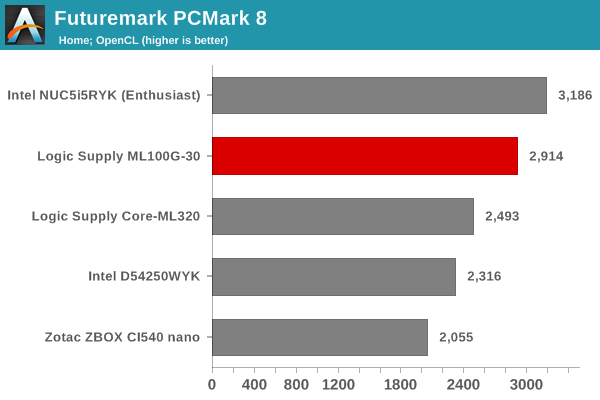
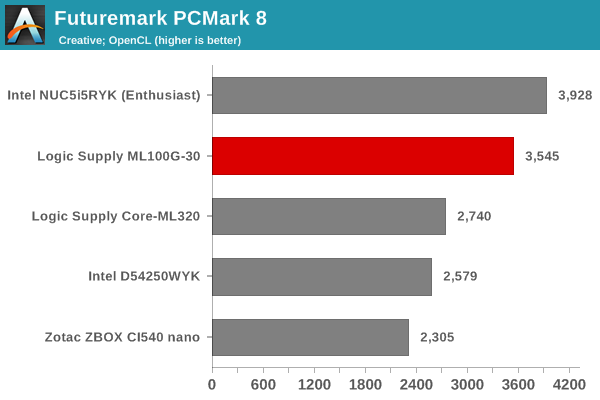
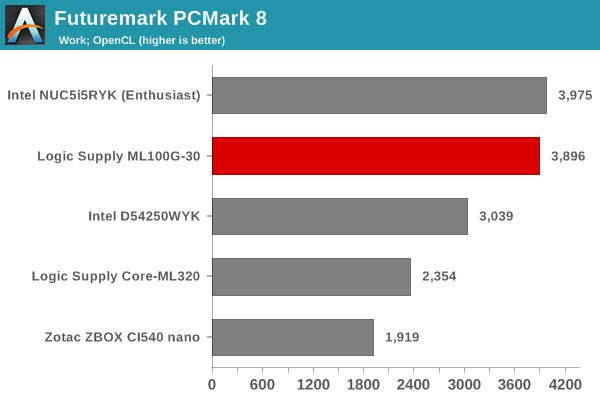
Miscellaneous Futuremark Benchmarks
The memory bottleneck also affects the other Futuremark benchmarks. Despite that limitation, the Broadwell vPro PC manages to score better than the previous generation passive NUC from Logic Supply. Note that the previous generation unit was also configured with dual-channel memory.
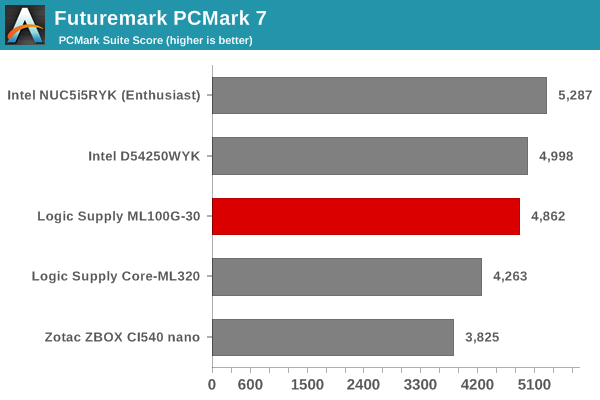

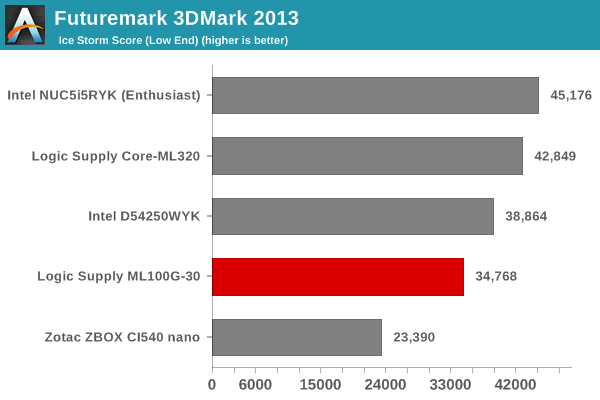

3D Rendering - CINEBENCH R15
We have moved on from R11.5 to R15 for 3D rendering evaluation. CINEBENCH R15 provides three benchmark modes - OpenGL, single threaded and multi-threaded. Evaluation of select PCs in all three modes provided us the following results.
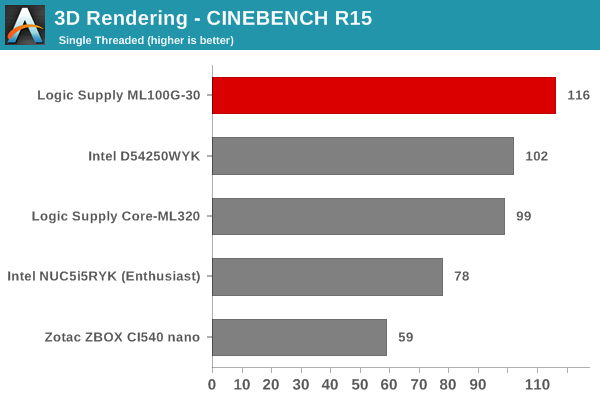


In the pure-CPU tests, the higher burst clock frequency (2.9 GHz) of the Core i5-5300U helps the ML100G-30 emerge as the leader. However, with the OpenGL routine, the memory aspect again comes into play.










34 Comments
View All Comments
Pissedoffyouth - Wednesday, April 29, 2015 - link
I have a build based on an Minibox M350 - designed for passive heatsinks or CPU's with fan and <65w TDP.With an A10-7800 it completely smokes these little boxes at a similar size, and for less money.
I'd love to see a NUC with an AMD APU and some decent cooling design
damianrobertjones - Wednesday, April 29, 2015 - link
I have an i7 quad machine that smokes your M350 machine. It's bigger than the Minibox but, then again, your minibox is bigger than the above Nuc.nathanddrews - Wednesday, April 29, 2015 - link
Oh yeah? Well epeen, epeen, epeen!TheinsanegamerN - Wednesday, April 29, 2015 - link
And my desktop smashes both of yours put together. Do I win?Pissedoffyouth - Wednesday, April 29, 2015 - link
Smokes it? What i7? I bet its GPU is worseSamus - Wednesday, April 29, 2015 - link
Broadwell's i7-5557U GPU is pretty damn close to a 192-core GCN GPU but nowhere near a 384+ core GCN GPU such as that in the A10. But it's also 1/4th the TDP, so half the GPU performance and 20% more CPU performance is all well unless you actually plan to game (at low res) on the thing because lets be honest here, both GPU's are unacceptable for HD gaming.It's also worth pointing out the Intel GPU is substantially more advanced regarding features and modern codec support.
blue_urban_sky - Thursday, April 30, 2015 - link
I presumed he was pointing out that if you are using a bigger chassis then it is easy to get a faster system. Your system is 192 x 210 x 62 (2.5l) this is 142 x 62 x 107 (0.95l)Haravikk - Thursday, April 30, 2015 - link
I have an i7-4790T in an Akasa Euler case; I believe it's around the size of the M350, similar price too (at least here in the UK) but a fully aluminium case designed as a heat-sink. The 4790T is 45W, but runs extremely well in the case; running a 1080p encode in Handbrake it can hold 750% CPU use (where all 8 threads is 800%) at a speed of 3ghz, even though it's normal operating speed is 2.7ghz.The only issue with this setup is that mSATA drives are out, as too much heat builds up in the case; I had to swap for a regular 2.5" SSD, and I did put a tiny 40mm Noctua fan in just to help clear the heat build up under heavy load (during normal use it switches off completely).
I'm not aware of any Broadwell compatible thin mini-ITX boards yet, but I imagine doing the same again with Broadwell could achieve even better results.
It does make me wonder why so many of these boxes have such anaemic CPU options, as it's clearly possible to put fairly powerful CPUs in. In fact, my (mostly) passive system replaced a 2008 dual quad-core Mac Pro, and outperforms it in almost every metric in such a tiny system. No ECC of course, but otherwise it's a pretty big (or small) change.
Pissedoffyouth - Thursday, April 30, 2015 - link
That does look like a pretty decent casenatenu - Sunday, May 10, 2015 - link
One of the reasons industrial PCs have lower powered CPUs is not only for thermal reasons but in order to have an industrial control panel be UL 508 approved any PC inside of it needs to be powered by a class 2 DC power supply. That is a power supply that cannot supply more than 100 watts.